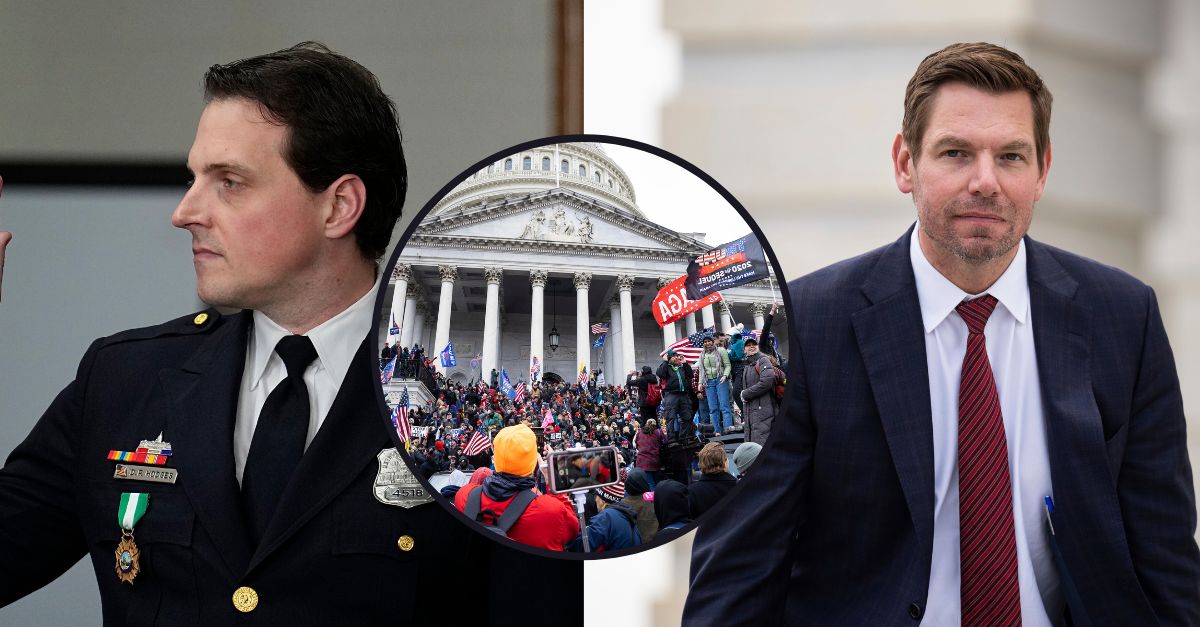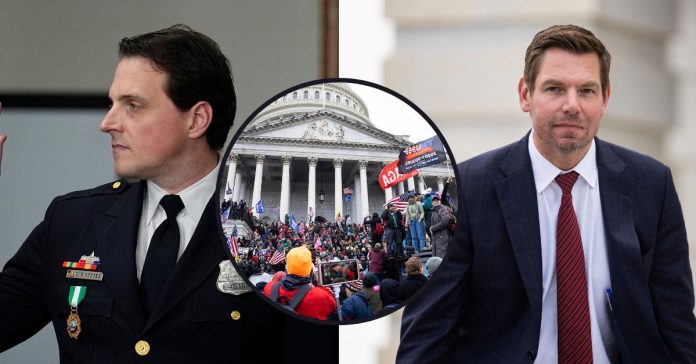
Left: Washington DC Police Department officer Daniel Hodges is sworn in before testifying during a lawsuit to keep former President Donald Trump off the state ballot, in court Monday, Oct. 30, 2023, in Denver. (AP Photo/Jack Dempsey). Right: Rep. Eric Swalwell, D-Calif., walks up the House steps for a vote in the Capitol on Thursday, September 28, 2023. (Bill Clark/CQ Roll Call via AP Images). Inset: Supporters of President Trump occupy the east front steps of the U.S. Capitol after breaching the security perimeter as they protest the certification of President-elect Biden’s electoral-college victory Jan. 6, 2021. (Francis Chung/POLITICO via AP Images).
“The events were horrific. It was a terrorist attack on the United States of America, an assault on democracy and an attempt to prevent the peaceful transfer of power,” D.C. Metropolitan Police Officer Daniel Hodges testified on Monday for the first day of trial in Colorado where a group of mostly Republican voters seek to disqualify Donald Trump from ever again serving in public office.
Hodges was nearly crushed to death in the tunnel of the West Terrace on Jan. 6, 2021, as he defended the Capitol from a mob of the former president’s supporters. He was pepper sprayed, beaten in the head, punched in the face and kicked in the chest. All of it, over and over again. And sitting in 2nd Judicial District Judge Sarah Wallace’s courtroom in Denver on Monday, his voice hardly wavered as he spoke.
Until he began reliving a moment in the tunnel of the Capitol’s West Terrace when a rioter tried to gouge his eye from its socket.
“He grabbed my face and tried to dig at my eye and push it out the best he could,” Hodges recalled, saying in that moment he was afraid for his life, for his colleagues’ lives, for the people inside the Capitol, Congress and then-Vice President Mike Pence.
He feared that if the mob gained control of the Capitol, it would “make good on all of the threats” he heard screamed at him that morning as he pushed his way from the street he was patrolling to the inside of the complex.
Inside of the tunnel it was extremely loud, chemical munitions were being fired off, and he was being “compressed” tightly against rioters and fellow officers. The chant Hodges recalled hearing the most on Jan. 6 was “Fight for Trump,” he said.
As he could feel his senses diminishing, he testified, he realized he was “trapped.”
“So I did the only thing I could do,” he said. “I called for help.”
Roughly twenty minutes before the moment Hodges reached his last resort, attorneys for Citizens for Responsibility and Ethics in Washington (CREW) noted Monday, Trump had posted a tweet turning up the temperature instead of dialing it down.
“Mike Pence didn’t have the courage to do what should have been done to protect our Country and our Constitution, giving States a chance to certify a corrected set of facts, not the fraudulent or inaccurate ones which they were asked to previously certify. USA demands the truth!” Trump posted on Twitter at 2:24 p.m.
Help could have — and would have have — come far earlier and faster to Hodges and other police on Jan. 6 if Trump had called off the mob vigorously, the police officer testified. Trump’s speech at the Ellipse fueled people who were peaceful and violent alike to “march to the Capitol” and swarm it as they hoped to stop the certification of an election Trump had convinced them was “stolen.”
One man, he recalled, refused to leave when he ordered him to.
“‘That ain’t gonna happen,”” Hodges recalled him saying.
“I understood the shouts [of ‘traitor!’] to mean that they disapproved of our being there, protecting the Capitol. it was antithetical to their goals. by protecting the capitol, we were traitors to the U.S.,” he added.
Hodges’ testimony goes to the very heart of why voters in Colorado have sued to remove Trump from the ballot in 2024. They allege his incitement of violence, his dereliction in failing to call down the mob for more than three hours and his pressure campaign on Pence and other officials culminated in a direct violation of Section III of the Fourteenth Amendment.
In short, the provision bars any individual from serving in office who has sworn an oath to the Constitution and then aided insurrection against it or acted in force against U.S. government, or provided comfort to its enemies.
Trump’s conduct in the run-up to and on Jan. 6 meets that definition, CREW argued.
“[Trump] helped the mob by refusing to mobilize resources to stop the attack. He spent three hours watching it unfold on television without doing a single thing even though he was the most powerful person in the world,” Olson said.
As the trial unfolds throughout this week — it is expected to end by Nov. 3 — Olson said the former president’s attorneys in Colorado will attempt to argue that Trump did not technically “engage” in insurrection.
Olson said Trump’s lawyers will argue that it was not his fault the Capitol was not sufficiently protected and if there was an “insurrection,” it was not his supporters who initiated the violence, but someone else. Trump will argue that he tried to send people to the Capitol to help tamp down the mob as it started to explode, Olsen said, but the voters he represents will make the case that there is no evidence to support that claim.
Trump’s attorneys briefly cross-examined Hodges on Monday, but mostly kept their questions limited to the crowd size. Hodges told the former president’s attorneys he suspected there was close to 10,000 people at the Capitol. Trump’s lawyers suggested there may have been 120,000. Hodges said he had not heard of that estimate before but in any event, the mixing of violent rioters and peaceful protesters made the crowd unmanageable and dangerous.
Trump’s lawyers contend that the voters challenging Trump’s placement on the ballot are politically motivated and that they will prove over the next week that there wasn’t a “mind meld mob” that Trump was able to inspire on Jan. 6.
They also plan to argue that because he is a “candidate” in Colorado and not officially on any ballot there yet, he cannot be removed in advance by Colorado Secretary of State Jena Griswold as the petitioners have requested.
In addition to Hodges, the court also heard testimony from Rep. Eric Swalwell, a California Democrat who helped preside over ceremonies at the Capitol on Jan. 6.
He also recounted the terror he experienced that day. That morning when he went for his daily jog, he said, he recalled seeing a man who was did not appear to be a member of the military wearing fatigues. He lifted his face mask, he said, to hide his identity in case the man recognized him as a lawmaker.
From that point in the day onward, he was unsettled, he said. But he went to Congress that afternoon and by the time the first wave of rioters got inside, then-Speaker of the House Nancy Pelosi was being whisked away and another lawmaker, Rep. Jim McGovern, tried to keep the certification going.
The attempt was short lived. Everyone’s phones were in their hands Swalwell said, and they were watching developments online as Capitol Police told them a mob had assembled and pipe bombs were dropped in the area.
Near the time Trump sent the 2:24 p.m. tweet and perimeters had been breached, police were stacking furniture against the doors of the chamber where lawmakers like Swalwell were stuck, Swalwell said. That was when Rep. Ruben Gallego, an Arizona Democrat, handed him a pen.
“‘If any of them come near you, just put that in their neck,’” Swalwell recalled Gallego, a military veteran, telling him.
Trump, who is represented by Scott Gessler, has tried and failed multiple times to dismiss the petition. He has tried to have Wallace recused but on Monday morning, the judge rejected that effort. Gessler argued she be recused because she one donated $100 to a group known as the “Colorado Turnout Project.” The group bills itself at aimed at preventing violent insurrections like Jan. 6.
Wallace rebuffed the allegation, saying she didn’t recall donating until Trump’s lawyers had filed. It wouldn’t matter anyway, she said, because she wouldn’t allow the trial to “turn into a circus.”
CREW will call several more witnesses this week, including a national security expert who they say will testify that Trump did not use all available federal resources to him to stop the mob, including resources he happily used to quell Black Lives Matter protests in the summer of 2020.
Have a tip we should know? [email protected]

